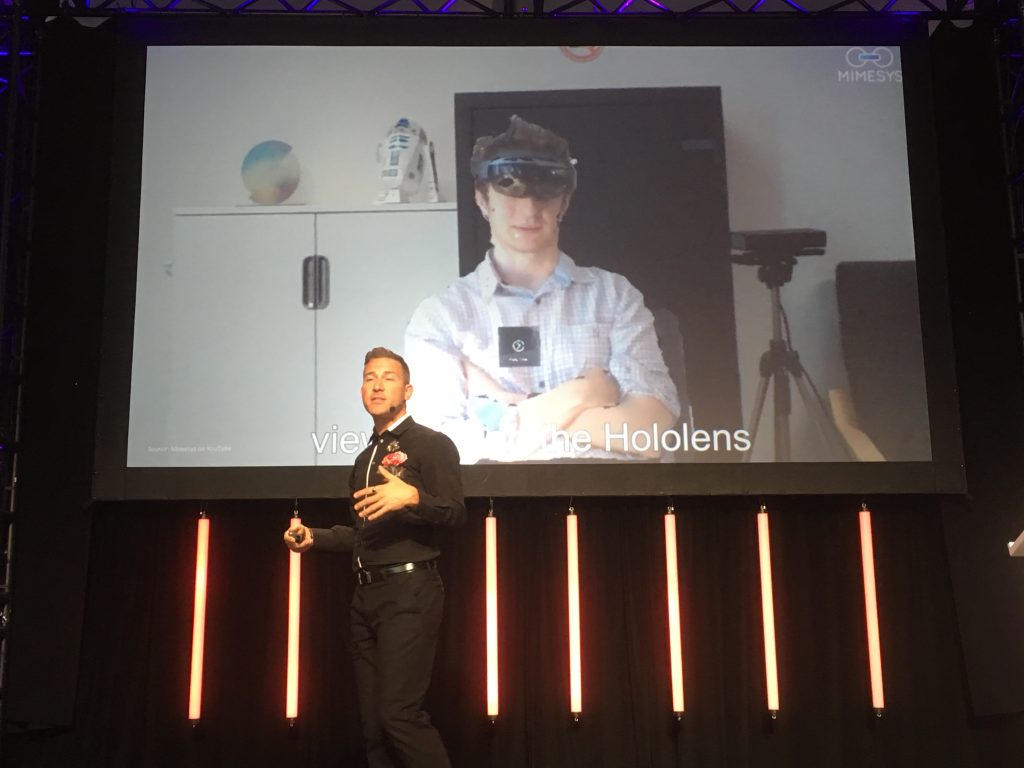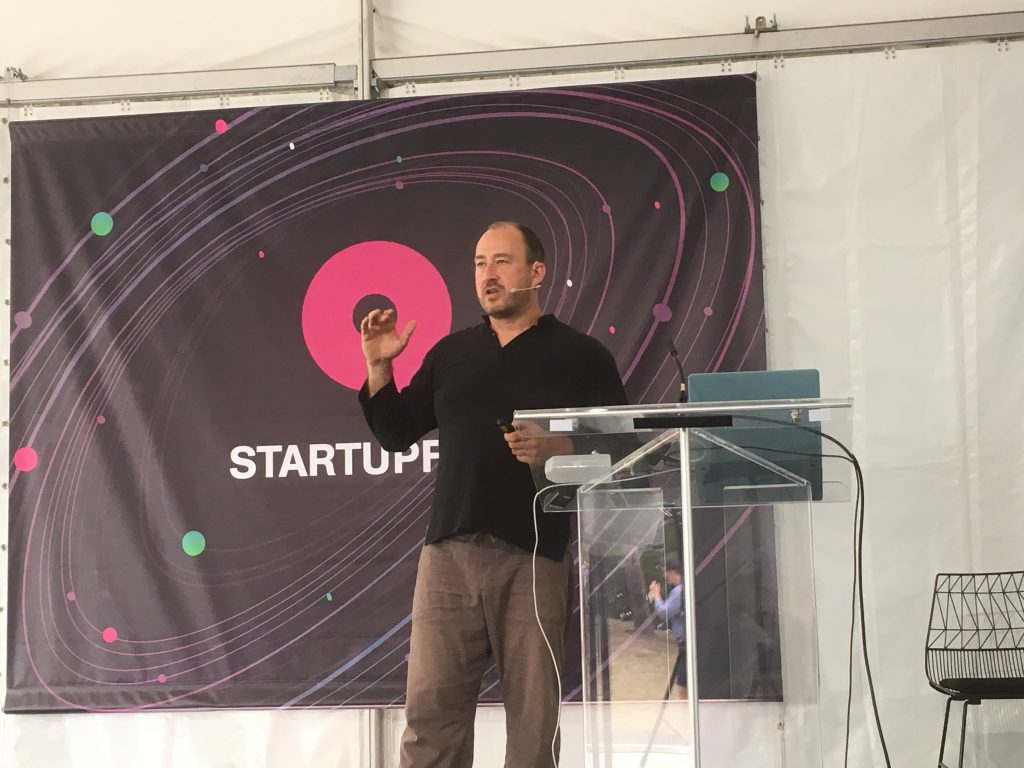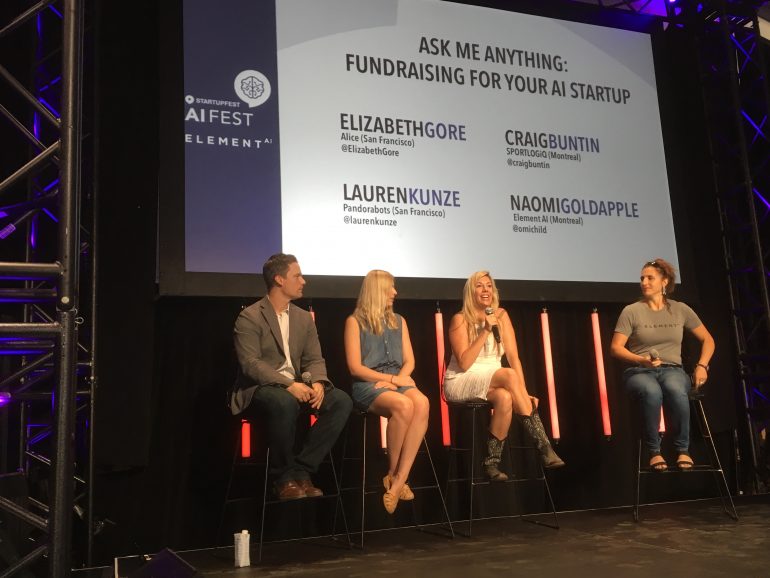On Friday, Startupfest raced through the future of AR, covering how to raise money as an AI startup—and whether or not you need to.
The morning session, “AR will devour the world,” started with a fast-paced look at an even faster-paced future of augmented reality, from giving your computer access to your own senses to brain chips, education, workplace competence, “holoportation,” discrimination, and literally wearing your emotions on your sleeve.
Wearables expert Tom Emrich explained that AR is picking up the pace with hardware from Apple and Google, as well as progress from Adobe, Verizon, Snap, and Facebook, but pre-requisites for an AR revolution include an across-the-board upgrade to 5G and battery improvements.
How can marketers capture attention and make people care? By being real magicians instead of cheap birthday party clowns.
Scope AR is already offering real-time remote assistance and AR-guided smart instructions, said Emrich. “They can turn an amateur worker into a professional one with a button. Using a pair of smart glasses, mobile or tablet, they can provide a worker with step by step overlays to perform a task, or lend the eyes out of someone more experienced to help them troubleshoot or walk through a task.”
While this could lead to a democratization of tech jobs where lesser-skilled workers would be able to perform higher skilled tasks – in any country – and avatars could reduce racial discrimination, Emirch also acknowledged that avatars could cause more discrimination by creating a hierarchy based on the types of filters people could afford or access.
His prediction for an AR-based future is that physical consumerism will decline, but digital consumerism will rise, doubling economic growth. “Once smart glasses exist, why buy the physical product at all? We may all be wearing uniforms in the future and rooms with blank walls with a couch and table that we dress up with digital filters or digital objects.”
Besides questioning the hierarchy of filters, he didn’t dwell on whether all AR is good, ethical or necessary. To him, a Black Mirror-like memory box and a fluid identity as an avatar mean progress.
“I can’t wait to be eaten,” he said.
Raising money for AI startups
The Ask Me Anything panel on fundraising for your AI Startup deserved better than the small crowd it drew, but while the rest of the approximately 7,000 festival attendees were off on Brain Dates and eating fish tacos by the food trucks, audience members gained valuable insights into how to bootstrap, raise, and the wisdom to know when each is best.
Lauren Kunze, the CEO Pandorabots, the world’s leading platform for building and deploying chatbots, said her company was and still is completely self-funded on revenue. But bootstrapping has taken years off her life, she said, and she may yet decide to raise. “We’ve lost three engineers to Facebook who can pay four or five times what a person should pay another person.”
Naomi Goldapple, director of industry solutions at Element AI, said that before joining the AI startup, she had her own company.While looking for VC is now almost an accepted practice, back then it wasn’t an option. “We didn’t call it fundraising then,” she said. “We called it writing a business plan, going to a bank and getting a small business loan.”

Elizabeth Gore, co-founder and president of AI platform Alice—which is now raising its Series A—said to look to other sources of funding, including government and scientific grants, before giving up capital. Once you do raise money from investors, expect a lot of ‘no’s.’ “I had 190 ‘no’s’ to get to six ‘yesses.’ We got three ‘no’s’ today, but we also got a ‘yes’ on a grant,” she explained.
Craig Buntin, co-founder and CEO of sports tech company SPORTLOGiQ, said that what surprised him most was the irrationality of fundraising, in that he’d go into pitch sessions to present how well SPORTLOGiQ was performing as a company and investors only seemed to care about how groundbreaking the tech was and the grand vision of the company.
“We went to raise money with a logical plan–this is our product, this is our sales, these are our customers–and it almost didn’t matter,” he said. “The only thing that actually mattered in fundraising was the grand vision. How big is this opportunity and how world changing is this technology? That was the only thing that actually drove valuation. And when you’re pre-seed and you’re investing in research, executing as a company actually kind of went against us.”
Buntin contrasted this with his experience at Montreal incubator TandemLaunch, where vision was just one part of the tech. “They were in because they saw us figure out how to find solutions to make customers happy. The company’s been three years and growing because we execute.”
“The problem with traditional marketing in a post-flip world is that it creates more information, which competes with the abundance of information that already exists.”
For AI companies that have a consumer product where monetization also comes from data, pitching both can throw off investors, so it’s important to focus your pitch on each VC’s expertise. “We’re looking for specific types of investors who will help us tailor on both sides. If we’re going into a heavy machine learning group, we focus on that piece and put consumer in the back. If someone’s focusing on our data, we push that. A few meetings in, hopefully they will ask about both, because one supports the other, but I think those first couple, knowing your audience and pitching to that audience and what they understand, as simply as possible, is important. I certainly think I was doing too much at first.”
All the panelists agreed that companies should look beyond the cheque when seeking VC money. Kunze recommended looking at the types of companies in which a VC has already invested to find the right fit.
Gore added that Alice is currently targeting investors within specific networks and even countries. “Particularly in a later round, we’re trying to find folks that aren’t just writing us a cheque,” she said. “We have strategic holes in our knowledge set or our network or geography – we’re actually looking for folks in specific countries too. We’re looking for someone who really understands data, in three geographies. And there’s a specific consumer piece of our business that we’re trying to find.”
It’s still not easy, added Gore, because she generally needs to find five investors who could fill a particular hole just to find one who will say yes. “But it’s okay to shoot for the stars sometimes,” she said.
How to be just evil enough
In what was probably the most entertaining presentation of the day, CEO of Solve for Interesting Alistair Croll talked about the stupidity of growth hacks versus market hacks, and the genius of Kraft Dinner.
Croll’s experience improving early-stage companies’ go-to-market strategies and updating the business models of some of the world’s largest firms drove home the point that outdated marketing strategies don’t do what they need to do these days: get people to care.
“It took a hundred million hours to build Wikipedia. Americans alone spend that time watching commercials in one weekend,” he said. “We should be asking ourselves, why aren’t we making more things?”

One thing people do care about, he said, is a viral egg video that serves as an example of how digital advertising has flipped from paying for viewers to being paid for viewers. “It’s a plastic egg and somebody opens the egg and takes the thing out. It’s seven minutes and 40 seconds long. Over and over again. This video has 652 million views. That’s not the scary part. The scary part is that this person didn’t have to pay to reach those viewers, it’s that they got paid to reach 652 million viewers. We haven’t just declined the cost of digital. We’ve flipped the cost of viewers.”
This flip takes us from a “tragedy of the commons to a triumph of the commons,” he added. “We are an abundance of available information. The problem with traditional marketing in a post-flip world is that it creates more information, which competes with the abundance of information that already exists.”
Building growth hacking strategies
How can marketers capture attention and make people care? By being real magicians instead of cheap birthday party clowns, said Croll – invent your own tricks. In the same way Farmville posted to your Facebook feed until Facebook realized they probably shouldn’t allow it, Croll suggests small companies find a zero-day growth exploit.
If you Google the term “growth hack” to create a strategy for your company, you’re not hacking correctly, he said. Any growth hack published online isn’t new, so the Facebooks of the worlds have probably already shut it down or reduced its effectiveness. The trick is to be the first to use it.
And if you play by an advertising company’s rules, (e.g. if you’re following a CPM or other standard model), unless you’re a huge company, it’s probably not worth it. “Don’t use attention-getting platforms on their terms,” he said.
According to Croll, when designing your hack, you need to know what kind of feature to push: functional, onboarding, acquisition, or market development. “If the market is saturated, you need market development features,” he said. Acquisition features include inviting a friend to Dropbox so you both get more storage, and onboarding features to make customers stick around, like World of Warcraft making your avatar look cooler when you get to higher levels.
Other examples of successful market hacks include Airbnb sending professional photographers to take shots of listed properties, which were then rented for more money, thereby also making Airbnb more money; Avis marketing themselves as the second best car rental company and claiming that meant they’d work harder to make you happy (they had to change their strategy when they became #1); and Kraft Dinner taking a floundering technological innovation (cheaply made powdered cheese), packaging it with dried pasta in an elastic band, and selling 8 million boxes in its first year.
“The value they were selling was the elastic band,” said Croll.


